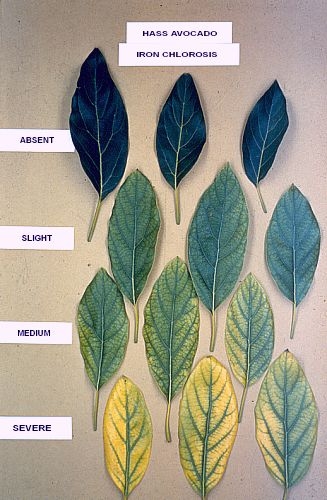- Author: Ben Faber
A recent trip to Spain was an opportunity to look at their cherimoya production practices. One of the most interesting is their ability to manage the tree through pruning to produce fruit off-season (in spring) when the prices are the highest. IN California our low period of production is in the summer. The climate in Spain along the Mediterranean coast is warmer and more humid than coastal California, so most tree crops are about two months advanced in their production. So in the text I refer to a period when something is done and then follow it with another date. The one in parenthesis is the probable time in California if the date in Spain is used. So, to produce fruit in spring (summer) in March/April when prices are high:
Remove all shoots from the previous year in March (May)
With the new shoots, prune them back 6 inches in length around July 15 (September 15)
Pollinate the flowers that are produced in the period of August to September (Sept/Nov)
Pick fruit in March/April (June/Aug)
Advantages:
Fruit is produced when prices are higher
Generally fewer seeds than at other periods
In some cases there is higher sugar content in the off-season frui
Disadvantages:
Not always consistent with all cultivars
Off-season fruit often has black spots in the pulp
May see increased leaf drop
In some cultivars, the skin is more prone to abrasion, and this is already a very delicate fruit
There are other fruit species that fruiting date can be manipulated by pruning, such as evergreen blueberries, guava, lime, mango and carambola (star fruit). Always it is to find a better market for the fruit.
X
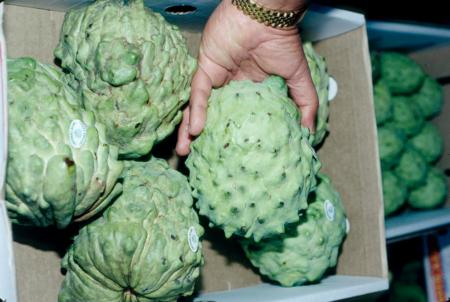
- Author: Ben Faber
Assessing water quality for Southern California agriculture typically revolves around the total salinity of the water, its total dissolved solids (TDS), and the toxic ions boron, sodium and chloride. Salts are necessary to plants, because it is in the form of diluted salts that all nutrients are taken up by plants- the macro and micronutrients plants extract from the soil. High salinity leads to water imbalance problems much as if the plant were not getting adequate water. A toxicity problem is different from a salinity problem, in that toxicity is a result of damage within the plant rather than a water shortage. Toxicity results when the plant takes up the toxic ions and accumulates the ions in the leaf. The leaf damage that occurs from both toxicity and salinity are similar in that it causes tissue death known commonly as "tip burn." The damage that occurs depends on the concentration of the ions in the soil water around the roots, the crop sensitivity and crop water use, and the length of time the crop experiences the ions. In many cases, yield reduction occurs. Because crops can not excrete salts the way humans do, salts gradually accumulate in a plant. As a result plants need a higher water quality than humans do.
Much study in many countries has gone into evaluating water for crop use. Some of these studies have been on the effects of salts on soil characteristics. Generally, as sodium concentration increases, a soil will lose its aggregation, eventually leading to poor water infiltration. Many more salinity and toxicity studies have been done on plants themselves. Not all crops are equally tolerant of salinity and toxicities, and in general most plants respond to salinity and toxicities in a similar fashion. If a plant is intolerant of salinity, it will be intolerant of chloride, sodium and boron. Most annual crops are less sensitive to salts than tree crops and woody perennials, although symptoms can appear on any crop if concentrations are high enough. The reason for greater sensitivity for perennial crops is that the tree is sitting in the ground absorbing salts for a longer period than the lettuce plant that is harvested 3 months after planting. Furthermore, deciduous trees like walnut shed their leaves each winter, so they can handle salinity better than evergreens like citrus and avocado.
To manage salinity and toxicities, water management is the key. Depending on water quality, an excess of water will be applied to the soil to leach the previously applied salts away from the root zone. The poorer the water quality, the more excess water is applied.
Selecting a less sensitive crop is also an alternative when dealing with poor water quality. Some barley varieties can handle salinity similar to ocean water. Barley nets a grower $400 an acre, avocados $9,000 and $25,000 if the market is right for strawberries. Avocados are salt sensitive, so are strawberries and lemons and cherimoyas and star fruit and blueberries and raspberries and mandarins and nursery crops. We grow these because with our climate, very few other places can grow them and they return enough money for a grower to stay in business in an area where land, water and labor are expensive. We really don't have much in "alternative crops" to grow here.
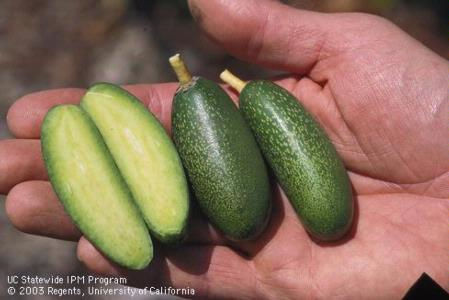
- Author: Ben Faber
- Author: Robert Vieth
The cherimoya is regarded by many as being among the best of tropical fruits. The cherimoya has a texture of a soft, non-gritty pear and a delicate, highly appealing fruit flavor with little acidity. Cherimoyas usually are eaten fresh; however they are excellent in ice cream and sherbets. The seeds, leaves, and limbs contain poisonous alkaloids that have been used to kill lice. Taken internally, these alkaloids act as an emetic and cathartic and should be regarded as poisonous. The biggest drawbacks in production in California are that the flowers usually require hand pollination to ensure a good set of fruit, and ripen over an extended period; however, from a marketing standpoint these shortcomings can be turned into advantages. A recent appearance or introduction into the Santa Barbara area, of the trash beetle or Rove beetle (Staphylinidae), may provide sufficient pollination to eliminate the need for hand pollination. The species is not readily grown outside of its native (high elevation tropics) habitat. In the United States, only the southern California coastal climates are conducive to cherimoya production. Southeast Asians and Hispanics prize the fruit and a national market has been established in gourmet groceries. The fruit commands a premium price in these limited market places.
Botany
The Annonaceae family consists of 50 genera of which Annona (about 100 species) and Rollinia (about 50 species) are the most important commercially. The most esteemed of the fruits of this family is theAnnona cherimola. The family is tropical and semi-deciduous in habit. The cherimoya drops its leaves in late spring (or early summer) after which it blooms. Its leaves are alternate, ovate to elliptical (1.5 to 3.5 inches wide by 3 to 6 inches long) with a slightly hairy upper surface.
The family exhibits a protogynous dichogamous flowering habit, that is, complete flowers in which the stigma is receptive before the pollen is ready to shed from the anthers. This condition is very important in cherimoya since the configuration of its flowers is not conducive to pollination by natural means. Therefore, pollination is done by hand: pollen is usually collected in the late afternoon or evening, stored in a cool place, and applied to the mature stigmas which are usually receptive in the morning. Cherimoya flowers, borne solitary or in groups of 2 or 3, are pendulous having three fleshy petals, a green to brown exterior, white interior, and are 1 to 2 inches in length.
As is typical of the family, the cherimoya fruit is formed by the fusion or partial fusion of the carpels resulting in a more or less bumpy fruit with many seeds. Cherimoyas ripen in 5 to 8 months after pollination changing in color from a darker to a light green or greenish tan, 3 to 8 inch ovoid weighing 1/2 to 6 lbs. In California fruit ripens from November to June.
Other members of the family that are grown for their fruit are:
- Sugar apple or custard apple (Annona squamosa)
- Atemoya (A. squamosa & A. cherimola)
- Soursop (Annona muricata)
- Ilama (Annona diversifolia)
- Bullock's heart (Annona reticulata)
- Biriba (Rollinia deliciosa)
- Pawpaw (Asimina triloba)
Annona squamosa resembles the cherimoya in texture and flavor and, since it is the more widely adaptable to humid conditions, it is the most widely planted in the more tropical parts of the world.
Climatic requirements
All of the species grown for fruit require a tropical or semitropical climate except for the pawpaw which is native to temperate North America. Moreover, all but the cherimoya are better adapted to wet tropical conditions. The cherimoya's home is the highland tropics which are often characterized as areas of eternal spring with temperatures seldom straying from the 60'so (F). There are wet and dry seasons with typical annual rainfalls being about 50 inches.
The cherimoya is adaptable to Mediterranean climates. In addition to San Diego and Santa Barbara and Ventura counties in the United States, significant commercial plantings have been made in Chile, Spain, Peru, Israel, New Zealand, Australia and Italy.
The cherimoya requires a relatively frost-free environment similar to lemons (short periods of 26oF for mature trees of hardy varieties). Some chilling seems beneficial (50 to 100 hours between 32oF and 45oF). However, a sunny location is needed since sufficient heat is required to develop a good flavor (inland, protection from extremely hot temperatures and dry winds is more important). In California most varieties do well extending 3 to 15 miles inland from the ocean. Further inland, care must be exercised in selecting a variety that will do well. The cherimoya will not tolerate prolonged high humidity, such as is encountered in Florida.
Soil Requirements
The most critical soil requirement is that of good drainage. Sandy loam or decomposed granite is preferred, but cherimoyas will succeed on many soil types with pH 5 to 8.
Cultural Requirements
Spacing
Trees are normally planted on 20 to 25 foot centers in California. Tighter centers are used where intensive pruning is employed.
Fertilization
Cherimoyas respond to fertilizer applications generally provided every 3 months with a balanced fertilizer such as 8-8-8. Yellow leaves may not indicate a need for fertilizer but may be a response to cold temperatures or to the soil being too dry or wet.
Pruning
Train to 2 scaffold branches. Severe pruning (2/3 of new growth) is popular in order to aid in picking. Only shoots that are approximately 60 degrees from trunk are normally saved.
Pests and Diseases
Cherimoyas are generally disease free. They are susceptible to Armillaria (oak root fungus) and Verticillium wilt. Good drainage and watering practices will minimize these problems. Similarly crown rot can occur if care is not taken in keeping the crown of the tree relatively dry. Ants are a problem since they promote mealy bugs on the fruit. Ants are most easily controlled by limiting access from the ground by placing a mechanical or acceptable chemical barrier on the trunk of the tree.
Propagation
Although seedlings have a good probability of producing acceptable fruit, trees are normally grafted or budded on seedling rootstock to ensure reliable results. Grafting is done in the spring at or before leaf drop. Scion wood should be collected just before leaf drop. Plants also can be rooted from cuttings, although it is somewhat difficult. Seed has good viability for 2 to 3 years if stored properly.
Harvesting and Storage
Harvesting is done by hand while the fruit is still firm on the tree (February to April depending on location). The crop is normally hand pollinated to ensure a long harvest season. Ripeness of fruit must be determined by the color of fruit. Depending on the variety, the fruit turns from a deep green to a light green or greenish tan.
The fruit is packed in single layer containers to prevent bruising. If stored, temperatures should not go below 50° F.
Fiscal
The fiscal aspects of orchard investment are similar to that of lemons.
Market
Market has exceeded demand and supported a significantly higher market price which offsets the need for hand pollination and picking.
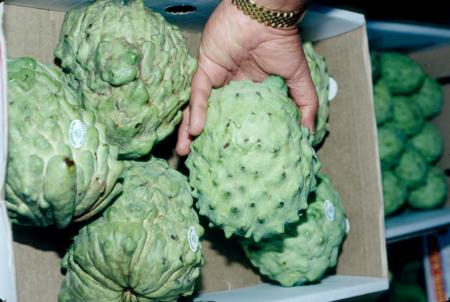
- Author: Scott Van Der Kar
Training
At planting (preferably in spring), if trees have an unbranched trunk greater than 2 feet tall, the tree should be headed back. This procedure should induce other buds along the trunk to shoot. Always remove leaves at positions where new shoots are required. Leaf removal is important since the petiole covers the bud and prevents bud break. Lower branches with weak crotches (less than 45°, or greater than 90°) should also be removed.
During the first summer one shoot is encouraged to dominate by lightly pinching back the other shoots and loosely tying the main shoot to the stake. This shoot (leader) will become the tree trunk.
About every three months some pruning can be performed to rapidly create a large framework. Select primary scaffolds beginning with the lowest facing the prevailing winds. Select additional scaffolds, upward along the leader at intervals of several inches or more, to form a spiral pattern around the trunk.
Head these scaffolds to 18 inches in length to maintain the central leader. Remove strong unsymmetrical growth not required as the leader or scaffold branches. Also remove any limbs with weak crotches. The position of scaffold branches can be selected by removing a leaf in the desired position, thereby uncovering the bud.
In subsequent years continue to select primary scaffold branches until four to six are present. Then allow the leader to become the topmost scaffold. Continue to head back scaffolds. Each time they are pruned, they tend to produce two strong end shoots. One or two weaker shoots might also form, these should be removed. As the pattern continues, the tree will gradually open up.
Pruning Bearing Trees
How heavily to prune depends on the variety and the tree's vigor as judged by the tree spacing, soil and climate. Unpruned trees initially bear substantially more fruit, but as the canopy becomes crowded, the inside becomes devoid of leaves and fruit, and production moves to the outside of the canopy. As a consequence, it is more difficult to pollinate and harvest, and more damage to fruit from branch rubbing is encouraged.
From the third or fourth year from planting the goal should be to prune about 6 to 8 inches from the new growth. This pruning should be done in the spring prior to bloom. If there is excessive growth during the summer, a light fall pruning may be necessary. However, heavy cropping will retard vegetative growth.
Each year branches that are crowding the center need to be thinned out along with dead wood. Fruiting wood that has grown more than 18 inches from the scaffolds also needs to be headed back to prevent the limbs from breaking with the weight of fruit.
The best level of pruning is going to be determined by experience. The severity of pruning will vary according to the lateral growth each season and cropping level. Other guidelines are to avoid too much shading within the canopy and to allow enough room between branches so that fruit will set clear of limbs and other fruit.
This is an abridged version of the pruning article in the California Cherimoya Association Handbook
Cherimoya fruit
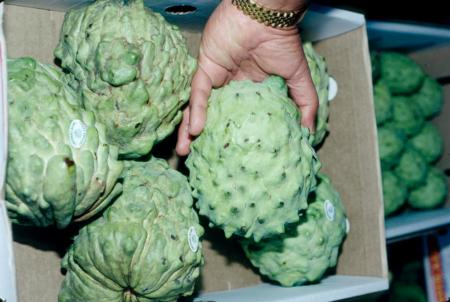
- Author: Elizabeth Fichtner and Rachel Elkins
Lime-induced Iron Chlorosis: a nutritional challenge in the culture of several subtropical perennial crops in California
Elizabeth Fichtner, UCCE Tulare County and Rachel Elkins, UCCE Lake and Mendocino Counties
Spring, and new leaves are coming out, but this could, but yellow could be a sign of iron chlorosis, as well.
Although iron (Fe) is the 4th most abundant element in the lithosphere, Fe deficiency is among the most common plant micronutrient deficiencies. Fe deficiency in plants is common in calcareous soils, waterlogged soils, sandy soils low in total Fe, and in peat and muck soils where organic matter chelates Fe, rendering the element unavailable for plant uptake. In California, lime-induced Fe deficiency is often observed in soils and irrigation water containing free lime, and is exacerbated by conditions that impede soil drainage (ie. compaction, high clay content), resulting in reductive conditions. Given that over 30% of the world's soils are calcareous, lime-induced Fe deficiency is a challenge in numerous perennial cropping systems including: grapes, pears, apple, citrus, avocado, pecans, and stone fruit (prune, almond, apricot, peach, nectarine, cherry).
In most soils, Fe oxides are the common source of Fe for plant nutrition. Solubility of Fe oxides is pH dependant; as pH increases, the free ionic forms of the micronutrient are changed to the hydroxy ions, and finally to the insoluble hydroxides or oxides. In calcareous soils, the bicarbonate ion inhibits mobilization of accumulated Fe from roots to foliage and directly affects availability of Fe in soil by buffering soil pH. When irrigation water is also high in bicarbonate, probability of Fe deficiency is enhanced because bicarbonate is continuously supplied to the soil, and more importantly, the roots may become crusted with lime as water evaporates, thus inhibiting root growth and function. Inside the plant, bicarbonate inhibits nutrient translocation from roots to aboveground plant parts. The adverse effects of high bicarbonate levels are exacerbated in very saturated, very dry, or compact soils, where bicarbonate levels increase concurrent with diminished root growth and nutrient uptake.
Symptoms of Fe deficiency in plants
Fe is immobile in plants; therefore, symptoms appear in young leaves. Interveinal chlorosis (Figure 1) is the main symptom associated with Fe deficiency, followed by reduced shoot and root growth, complete foliar chlorosis, defoliation, shoot dieback, and under severe conditions may result in tree mortality. Overall productivity (yield) is reduced, mainly from a reduced number of fruiting points.
Plant Adaptation
Plant species and cultivars vary in their sensitivity to Fe deficiency, and are categorized as either "Fe-efficient" or "Fe-inefficient". Fe-efficient plants have Fe uptake systems that are switched on under conditions of Fe deficiency. Fe-inefficient plants are unable to respond to Fe deficient conditions. All Fe-efficient plants, except grasses, utilize a Fe-uptake mechanism known as Strategy 1. Strategy 1 plants decrease rhizosphere pH by release of protons, thus increasing Fe solubility. Some plants may excrete organic compounds in the rhizosphere that reduce ferric iron (Fe3+) to the more soluble ferrous (Fe2+) forms or form soluble complexes that maintain Fe in solution. Additionally, roots of Strategy 1 plants have specialized mechanisms for reduction, uptake, and transfer of Fe within the plant. Strategy 2 plants (grasses) produce low molecular weight compounds called phytosiderophores which chelate Fe and take up the chelated Fe with a specific transport system.
Amelioration of Fe chlorosis
Planting sites in calcareous soils should be well drained to provide optimal conditions for root growth and nutrient uptake. Waterlogged and compact soils contain
more carbon dioxide, which reacts with lime to form even more bicarbonate. These conditions, as well as very dry soils, also inhibit microbial activity which aids in
solubilization and chelation of Fe. Prior to planting, soils and water should be tested to determine the pH, lime equivalent, and bicarbonate concentration. Bicarbonate concentrations greater than 3 meq/L in irrigation water increase the hazard of lime accumulation on and around roots. If high bicarbonate water must be used, the pH must be adjusted to 6.0-6.5 to dissolve the bicarbonate and prevent it from negating the effects of soil-based treatments. In microsprinker and drip systems, acidification of irrigation water will also reduce the risk of emitter clogging, a common problem at bicarbonate levels over 2 meq/L. The cost of reducing the pH of irrigation water will more than compensate for the savings incurred from avoiding wasted investment in failed soil- and plant-based remedies. Systems can be set up to continuously and safely inject water with acids such as sulfuric, urea-sulfuric, or phosphoric during irrigations. Specific choice and rate will depend on crop, soil type, other nutrient needs, availability, and cost. Downstream pH meters are available to continuously adjust rate of acid use. Acetic and citric acid can be utilized by organic growers.
Soil based pre-plant treatments to reduce pH include elemental sulfur (S) and acids as mentioned above. It is only necessary to treat a limited area near the root zone to ameliorate symptoms because the tree only needs to take up a small amount of Fe. Material can be shanked in or banded and incorporated in the prospective tree row. One ton of elemental sulfur per treated acre is needed to mitigate three tons of lime, and may need to be re-applied every 3 to 5 years after planting. The addition of organic matter such as well-composted manures will benefit poorly drained or compact soils by increasing aeration for better root growth, fostering chelation of nutrient cations, and reducing pH (depending on source material).
If possible, choose a Fe efficient species or cultivar. In perennial systems, lime-tolerant rootstocks may be the first line of defense in combating Fe deficiency. Some rootstocksmentioned are peach-almond and Krymsk-86 for stone fruit, Gisela 5 for cherry, and Pyrus communis for pear. Ongoing research studies in Europe focus on screening rootstocks of grape and olive for lime tolerance.
Once soil and water quality improvements are made, post-plant management strategies may also be implemented to ameliorate lime-induced Fe chlorosis in the short term. Soil can be acidified as described above. Individual trees can be treated by digging four to six 12-24 inch
holes around the drip line and burying a mixture of sulfur and Fe fertilizer. Historically, two principal methods have been utilized: 1) foliar application of inorganic Fe salts (ie. ferrous sulfate), and 2) soil or foliar application of synthetic chelates. Application of Fe salts to foliage may have mixed results due to limited penetration of Fe into leaves and inadequate mobilization within the plant. Use of Fe chelates may be of benefit; however, they are expensive and pose an environmental concern due to their mobility within the soil profile. Because soil lime interferes with Fe mobility with the plant, repeat application of inorganic Fe salts or Fe chelates may be necessary throughout the growing season.
Choice of nitrogen (N) fertilizer may also influence solubility of rhizosphere Fe. When N is applied in the ammonium form (NH4+), the root releases a proton (H+) to maintain a charge balance, thus reducing rhizosphere pH. Alternately, fertilization with nitrate (NO3-) results in root release of hydroxyl ions (OH-), resulting in an increase in rhizosphere pH. Solubility of Fe3+ increases 1000 fold with each one unit decrease in pH; therefore, fertility-induced rhizosphere pH changes may significantly influence Fe availability.
New methods for amelioration of Fe chlorosis are under investigation. For example, container studies have demonstrated that inter-planting sheep's fescue, a Strategy 2 plant, with a Fe-inefficient grape rootstock may ameliorate Fe chlorosis in grape. In this system, the grass produces a phytosiderophore that enhances Fe availability to the grape. Additionally, soil amendment with Fe3(PO4)2• 8H2O), a synthetic iron(II)-phosphate analogous to the mineral vivianite, has been effective at preventing Fe chlorosis in lemon, pear, olive, kiwi, and peach. Vivianite has a high Fe content (~30%) and serves as a slow release source of Fe in calcareous soils.
Figures below: 1) Shoot dieback in citrus, 2) Interveinal chlorosis in citrus and 3) Various stages of iron chlorosis in avocado.


